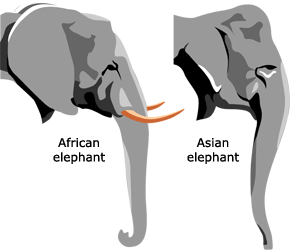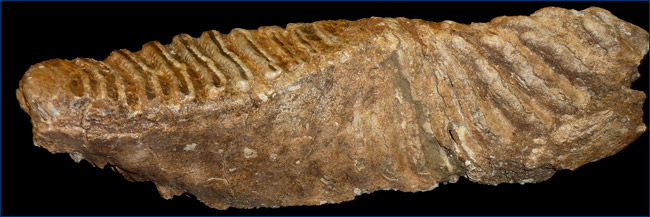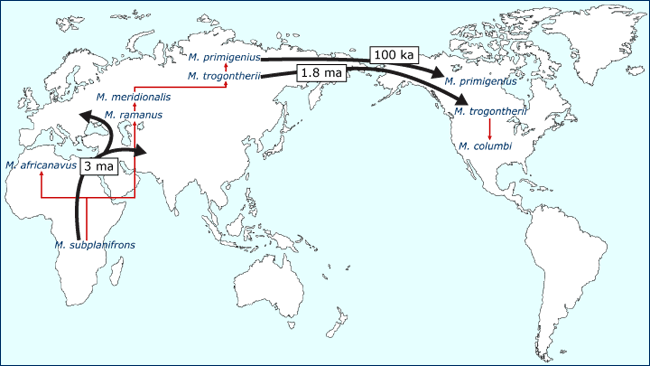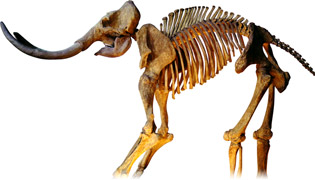
The Elephantidae
Elephants and mammoths
 |
The African Savanna Elephant on average is 10�11 feet tall at the shoulder and weighs between 4 and 6 tons at full size. It has a saddle-shaped back, low-domed head, gently upward-curving tusks, and large ears. The tip of the trunk has two "fingers," one upper and one lower. The smaller Asian Elephant is about 8�10 feet tall at the shoulder and weighs 3�5 tons. Its back is curved, giving the appearance of a humped back, and it has a double-domed head. The tusks are gently curved upwards but are smaller than the African Elephant's, and the ears are smaller as well. Lastly, the Asian Elephant has one "finger" at the tip of its trunk.
Ancestors of the family include Primelephas and Stegodibelodon. Morphological phylogenetic analyses indicate that Elephas and Mammuthus were sister taxa to Loxodonta (see the phylogeny below). These three elephants developed similar feeding morphologies in parallel to allow for specialized grazing. Changes included increasing the number of plates in the molar, decreasing the thickness of the tooth enamel, broadening and increasing the height of the molars, and anterior-posterior compression, as well as heightening, of the cranium. The shearing index of the primitive Primelephas was only 4 compared to the extreme condition in Mammuthus primigenius with its a shearing index of 27.
Loxodonta, Elephas and Mammuthus originated in Africa during the Pliocene (about 3�4 million years ago). Loxodonta remained in Africa while Elephas dispersed from Africa twice. The first dispersal event was in the mid-Pliocene, when Elephas moved into Asia; the extant Elephas maximus is a descendant of these emigrants. The second dispersal occurred in the late Pliocene when Elephas moved into Asia and Europe, but this dispersal resulted in extinct lineages. Mammuthus disappeared from Africa by the Pleistocene but dispersed to Europe, Asia and Africa in multiple events prior to this (see Mammoths below). While all three genera lived in Africa, they did not seem to compete with each other. In southern Africa, Loxodonta and Elephas do not occur in the same fossil assemblages; in other parts of the continent, the two genera are only rarely found together. It appears that Loxodonta only becomes abundant in eastern Africa once Elephas has disappeared from the area. While Elephas and Mammuthus developed high shearing indexes, Loxodonta changed very little and maintained a primitive shearing index of 5. Around 11,500 years ago, Elephas became extinct in Africa, and some species of Elephas disappeared from Europe. All members of the family became extinct in the Holocene except for the two living species.
 Phylogenetic relationships within the elephant family based on morphological characters. |
Mammoths
Mammoths were first described by German scientist Johann Friedrich Blumenback in 1799. He gave the name Elephas primigenius to elephant-like bones that had been found in Europe. Both Blumenbach and Baron Georges Cuvier of France concluded, independently, that the bones belonged to an extinct species. The bones belonged to the woolly mammoth, later considered to be a distinct genus, and so renamed Mammuthus primigenius.
Mammoths were large proboscideans that roamed the Earth during the Pliocene and Pleistocene (~5 mya to 11,500 years ago). They belong to the group of true elephants (Elephantidae) and are closely related to the two living species. Like living elephants, they do not have enamel on their tusks and have ridged, hypsodont molar teeth, but they differ in that their tusks twist in a spiral fashion.
 Lateral view of a hypsodont mammoth tooth. Note the low ridges, then compare this tooth with a mastodon tooth. |
The earliest mammoth (Mammuthus subplanifrons) originated in the tropical environments of Africa alongside the earliest ancestors of elephants; fossil specimens of M. subplanifrons have been found in South Africa and eastern Africa. M. africanuvus, a smaller mammoth from northern Africa, proved to be a "dead end" lineage. But M. subplanifrons was ancestral to M. rumanus, a species that migrated out of Africa and into Europe about three million years ago. The next mammoth in line, M. meridionalis, lived in Europe and Asia until 750,000 years ago. This well-known species was very large, reaching heights of 13 feet and weighing 10 tons. Plant fossils found with the numerous remains of M. meridionalis suggest that it lived in a deciduous mixed woodland habitat with a mild climate, although later populations appear to have lived in partially grassy habitats. This change in habitat preference reflects the spread of grasslands throughout Eurasia about two million years ago. It was at this time that M. trogontherii (the steppe mammoth), the sister taxon of M. meridionalis, evolved. This species had a widespread distribution from Eurasia (replacing M. meridionalis) to North America until approximately 500,000 years ago. M. trogontherii was ancestral to the more familiar M. primigenius (the woolly mammoth) and M. columbi (the Columbian mammoth).
 Mammoth migration and evolution around the world. Thick black lines indicate migration events of mammoths and thin red lines represent evolutionary relationships between mammoth species. |
Woolly mammoth
While M. trogontherii lived in a steppe environment in a moderate climate, the woolly mammoth adapted to cooler and more arid conditions. Its range covered the northern, treeless regions from the British Isles to eastern Siberia and into North America. There is fossil evidence suggesting that M. primigenius evolved as early as 750,000 years ago. Woolly mammoths were 9�11 feet tall when fully grown and weighed 4�6 tons. They had a sloping back with a single-domed head and curved, twisted tusks.
Through the evolution of mammoths from M. subplanifrons to the woolly mammoth, there was an overall progression toward teeth more adapted for eating grasses. This progression included an increased number of enamel ridges, and increased tooth height. Accompanying these changes were a deeper lower jaw to accommodate the higher-crowned teeth, larger tusks, and a taller skull to allow for larger muscle attachments for both chewing and for muscles to the back that were needed to counterbalance the weight of the tusks. In addition, the tusk sockets were directed downward rather than forward. Changes specific to the woolly mammoth that accompanied the move to colder and more arid climates included a reduction in ear and tail size as well as thicker skin and fur.
 Skeleton of a Columbian mammoth at The Mammoth Site of Hot Springs, SD. |
In populations of mammoths that lived on islands, individuals were severely reduced in size. On the Channel Islands off the coast of California these dwarfed mammoths are classified as a separate species, M. exilis. Another example of dwarf mammoths is from Wrangel Island in Siberia. This relict population of mammoths survived until 7,000 years ago, outlasting the two remaining lineages of mammoths, woolly and Columbian, that went extinct near the end of the Pleistocene around 11,500 years ago. Across every continent they went extinct, along with a number of other large mammals. The cause of these extinctions is still unknown. Some researchers blame the extinctions on a change in climate during this period. Others think the large mammals were over-hunted by humans. Each continent shows a pattern supported by one or the other hypothesis, or both. In general, most researchers are coming to a consensus that a combination of climate change and human pressure led to the extinction of large mammals around the world at the end of the Pleistocene.
Something to chew on
If mammoths were similar to elephants in their eating habits, they were very remarkable beasts. Consider the following facts about modern elephants:
Since most mammoths were larger than modern elephants, these numbers must have been higher for mammoths!
From the preserved dung of Columbian mammoths found in a Utah cave, a mammoth's diet consisted primarily of grasses, sedges, and rushes. Just 5% included saltbush wood and fruits, cactus fragments, sagebrush wood, water birch, and blue spruce. So, though primarily a grazer, the Columbian mammoth did a bit of browsing as well.
Who is sister to who?
It was originally thought that the African and Asian elephants were sister taxa to each other and mammoths were an earlier relative in their evolutionary history. However, studies using morphological characteristics conclude that mammoths and Asian elephants are closely related and African elephants branched off first (Shoshani et al. 1985). Phylogenetic studies using preserved DNA of woolly mammoths (Mammuthus primigenius) led to mixed results. In 1994, Hagelberg and others found the woolly mammoth to be more closely related to the African elephant while other studies (Yang et al. 1996, Ozawa et al. 1997) found that the woolly mammoth was more closely related to the Asian elephant. To confuse matters more, a recent study found that both relationships had equal probability (Orlando et al. 2007).
| African Elephant | Asian Elephant | Columbian Mammoth | Woolly Mammoth | American Mastodon | |
| Height | 10-11 ft | 8-10 ft | 12-13 ft | 9-11 ft | 8-10 ft |
| Weight | 4-6 tons | 3-5 tons | 10 tons | 4-6 tons | 4-5 tons |
| Back shape | Saddle-shaped | Humped | Slightly sloping | Sloping | Straight |
| Fur | Very sparse | Sparse | Sparse | Dense | Probably dense |
| Head | Low single dome | Double dome | High single dome | High single dome | Low single dome |
| Tusks | Gently curved upper tusks | Gently curved upper tusks | Greatly curved and twisted upper tusks | Curved and twisted upper tusks | Curved upper tusks, straight lower tusks |
| Alive | ~1.8 mya to Present | ~1.8 mya to Present | ~1 mya to 11,500 ya | 750,000 to 11,500 ya | ~4 mya to 11,500 ya |
New content researched and written by Kaitlin Maguire, 11/2010; new content merged with existing mammoth/mastodon page, 10/2011; mammoth tooth photo by Kaitlin Maguire; Columbian mammoth skeleton photo by Dave Smith